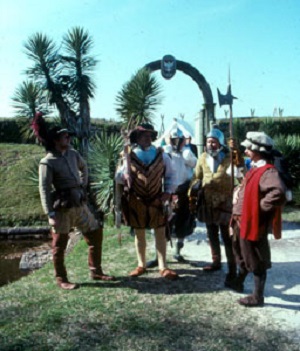
Courtesy of the National Park Service
Set within the boundaries of Timucuan Ecological and Historical Preserve, Fort Caroline National Memorial commemorates one of the first attempts by Europeans to found a colony in the New World. Two centuries of Spanish and French colonial rivalry in North America began here in 1564 when Admiral Gaspard de Coligny (1519 – 1572) envisioned Fort Caroline as a French challenge to established Spanish colonies, a potential commercial venture, and a shelter for Huguenots (French Calvinists). The fort quickly became a source of conflict, because Spain resented French intrusion and objected to the presence of Protestants on land the Catholic Spanish claimed.
Picked by Gaspard de Coligny, Jean Ribault led the first expedition in 1562 to establish the colony and arrived at a location on the present day St. Johns River in South Carolina, but a settlement there failed. René de Goulaine de Laudonnière led a second attempt and in 1564 established Fort Caroline near the mouth of the St. Johns River in Florida. This group of 200 named the area La Caroline after the French King Charles IX and began to construct permanent shelter and defenses and try to grow the colony.
The local Timucua initially helped the newly arrived French and provided assistance in building the fort and other structures. Timucuans had lived in the area and throughout northern Florida for at least 1,000 years before the arrival of the French and Spanish in the 1500s. The Timucua drew a large part of their identity from the water around them, depending on it for shellfish and fishing as main elements of their diet. In addition, they supported themselves through some land-based cultivation of crops. Although the Timucua and colonists had generally peaceful interactions, the Timucua ultimately suffered displacement by the arriving Europeans and decimation by foreign diseases. Today, no known Timucua remain.
Upset by the unwelcome French attempt to divert trade from Spain to France and take the riches of the New World while establishing a Protestant community, the Spanish responded quickly to the French settlement. King Philip II of Spain sent an armada led by Don Pedro Menéndez de Avilés to force the French out of Spanish-claimed Florida. Menéndez and his troops attacked the fort in the fall of 1565, killing most of the settlers they found; however, a sizeable number of the French left Fort Caroline before the attack intending to set upon Menéndez to defend the French claim to the land. A hurricane forced most of the group to beach just south of the fort. They became Menéndez’s next target. A few escaped the storm and returned to France; Menéndez killed the others at a place later called Matanzas (“killing” or “slaughter”). While both Spain and France hoped to use Florida as a base from which to expand their overseas empires, Menéndez's victory ended efforts by the French to establish a lasting presence in the Southeast.
In 1568, the French sought revenge for the 1565 massacre and sent Dominique de Gourgues to attack the fort. De Gourgues landed at Fort San Mateo (Fort Caroline) with three ships in April of 1568 and attacked, captured, and burned the fort killing the Spanish prisoners they took in retribution for the previous massacre of the French. Spain then rebuilt the fort only to abandon it the next year. France never again strongly challenged Spanish claims in North America.
Although the exact site of the fort is unknown, visitors to Fort Caroline can see a large-scale model based on contemporary drawings. Built in 1924 for the Daughters of the American Revolution, the fort model recreates the original depicted in drawings done by artists brought over to record life in the New World as part of the 1564 expedition. Other sites around the fort further document the story of Spanish and French colonization. These include a reproduction of a marker placed by Ribault in 1562 to claim this area of Florida for France and the supposed site where the Spanish camped before their attack on the settlers.Although the exact site of the fort is unknown, visitors to Fort Caroline can see a large-scale model based on contemporary drawings. Built in 1924 for the Daughters of the American Revolution, the fort model recreates the original depicted in drawings done by artists brought over to record life in the New World as part of the 1564 expedition. Other sites around the fort further document the story of Spanish and French colonization. These include a reproduction of a marker placed by Ribault in 1562 to claim this area of Florida for France and the supposed site where the Spanish camped before their attack on the settlers.
Fort Caroline National Memorial is part of the Timucuan Ecological and Historic Preserve, a unit of the National Park System. Fort Caroline and the visitor center are located at 12713 Fort Caroline Road in Jacksonville, FL. Click here for National Register of Historic Places file on the fort: text and photos.
The Timucuan Ecological and Historic Preserve also includes the Kingsley Plantation, Theodore Roosevelt Area, Cedar Point, and American Beach. The Visitor Center at Fort Caroline provides an orientation to the fort and other areas of the park. Fort Caroline and the Visitor Center are open daily from 9:00am to 5:00pm except for Thanksgiving, Christmas, and New Years Day. There is no fee to visit any part of the Timucuan Ecological and Historic Preserve. For more information, visit the National Park Service Timucuan Ecological and Historic Preserve website or call 904-641-7155.
Fort Caroline and the Timucuan Ecological and Historic Preserve are featured in the National Park Service Along the Georgia Florida Coast Travel Itinerary.
Last updated: August 9, 2017
